Procurement and Legal are both responsible for improving the overall health of a business by playing an active role in managing its contracts.
However, the measures of success for both teams can differ significantly - often resulting in a fragmented approach. When Legal and Procurement fail to collaborate, disruption can be felt more widely within the business and vulnerabilities around risk, compliance, poor performance and delinquent spend increase.
At a high level, procurement strategies has traditionally focused on cost savings and minimising risk within the supply chain while Legal has focused on compliance with industry regulations and the law.
However, as businesses grow and the supplier base becomes more complex, the responsibilities for compliance, risk mitigation and cost savings must be tightly coordinated and shared.
Both teams need to align their process, prioritise shared goals and have the right contract management tools in place to minimise risk and prevent suppliers from performing poorly."
In this article, we take a look at why Procurement and Legal need to collaborate more effectively and how Gatekeeper can help.
Time, money and quality: a shared vision between Legal and Procurement
Today’s Legal team is multi-faceted, with focus required across negotiations, reviews and approvals, risk mitigation and compliance, not to mention the accompanying contract administration. With so many areas of responsibility, efficiency in operation is vital to ensure contracts are signed within the shortest possible timeframes.
As with any business, time is money. As Procurement teams diversify the supplier base and contracting becomes more complex, Legal departments are often left working above their capacity. The result? Unintended inefficiencies that delay time-to-signature, cause bottlenecks in the procurement process and frustrate relationships between departments.
Improving internal efficiency, re-prioritising tasks so time is spent on areas of expertise and sharing ownership of contracts saves time and protects the business’s bottom line."
What successful contract management looks like for Legal and Procurement
Effective contract management is the bread and butter that keeps Legal and Procurement collaborating. But many businesses experience frustrations between the departments. These frustrations are commonly caused by:
- A lack of contract visibility preventing teams from working in sync
- Fragmented contracting processes so all agreements aren’t treated equally
- A lack of accountability for outcomes due to a lack of clear ownership
- The risk of non-compliance and missed renewals
- Important communications being missed through unreliable or busy channels.
Poor processes between Legal and Procurement are typically seen in businesses that manually manage their contracts. Agreements, clauses and documentation may be difficult to find.
The hand off between departments might not happen at the right time, or with enough information. Multiple versions of the same contract are likely to be circulating between the teams.
Legal and Procurement need to work from a single source of truth. If they’re working on different documents, different perceptions and different metadata, both teams will draw different conclusions. Successful contract management for these teams is based on accuracy and trust."
Without specific strategies and technologies in place, it's unlikely that teams will be able to achieve this. When contracts are buried in Excel sheets, stakeholders are kept in the dark or there is a lack of understanding across the business, Procurement and Legal will struggle to form the powerful partnerships needed.
Good contract management is based on:
- Centralised contracts that relevant teams can securely access and easily find
- Stakeholders having visibility of key dates
- Automated processes that alleviate administrative burdens from Procurement and Legal
- Teams being able to work harmoniously through all lifecycle stages, including negotiations and approvals
- Clear ownership of agreements and their outcomes.
Contract management software can help Procurement and Legal teams meet in the middle of this common business goal. Technology can transform a loose shared vision of “greater efficiency” into action. Automation will unlock time savings for both teams, speed up time-to-signature and streamline complex processes to improve contract outcomes.
How Gatekeeper brings Procurement and Legal together
Gatekeeper is a contract and vendor management software designed for the entire organisation. When processes are visible, standardised and a complete audit trail can be created for all actions taken, Procurement and Legal can work together more collaboratively - with visibility on how each team is working.
Contract management software transforms manual, fragmented processes which historically can keep teams in silos. It allows all teams to work towards the same goals as a cohesive unit."
Below, we look at some Gatekeeper features that benefit both teams.
1. Automate and standardise internal processes for seamless collaboration
With contract management software in place, there is no reason for Legal and Procurement to work manually or work in silos. Gatekeeper’s Kanban Workflow Engine gives teams the ability to design, build and automate internal processes - including supplier invitations, legal reviews, negotiations and contract approvals.
As contract workflows are customisable to your business’s needs, Procurement and Legal can agree and standardise a process that is mutually beneficial, optimised for efficiency and visible to all stakeholders.
.png?width=1200&name=Gatekeeper%20cartoon%20(1).png) Courtesy of Laura Frederick, Contracts Expert
Courtesy of Laura Frederick, Contracts Expert
With this increased visibility, Procurement no longer needs to chase Legal for updates or vice versa. Notifications are also sent to each team when their input is required. This minimises disruption so Legal can focus their expertise on the negotiations, reviews or approvals required as part of the procurement process.
Gatekeeper gives organisations insight into their bottlenecks. Once identified, Legal and Procurement can work together to diagnose the issue, resolve the delay and optimise processes in the future."
Legal and Procurement can increase the efficiency of their contracting process with:
- Auto-Actions which allow teams to automate individual steps or entire workflows
- Workflow Reporting which calculates average contracting time
- Conditional Logic to automatically route approvals to stakeholders
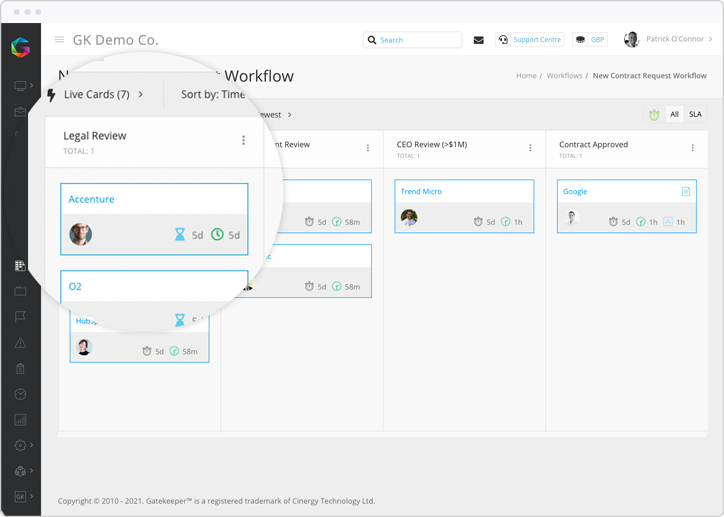 Automate collaboration between Legal & Procurement
Automate collaboration between Legal & Procurement
2. Review and approve suppliers in parallel
Not only does contract management enhance the collaboration between Legal and Procurement, it also allows them to work at the same time. This is particularly useful at the review and approval phase of the procurement process.
Legal can take time to review the strength of the contract in terms of clause language, obligations and compliance, while Procurement can focus on the viability of the supplier and the commercial terms."
The ability to work in parallel means that Legal can prioritise risk identification and mitigation, without lengthening the procurement process. This efficiency allows both teams to collaborate, keep the procurement cycle short and capitalise on potential savings such as time-related discounts.
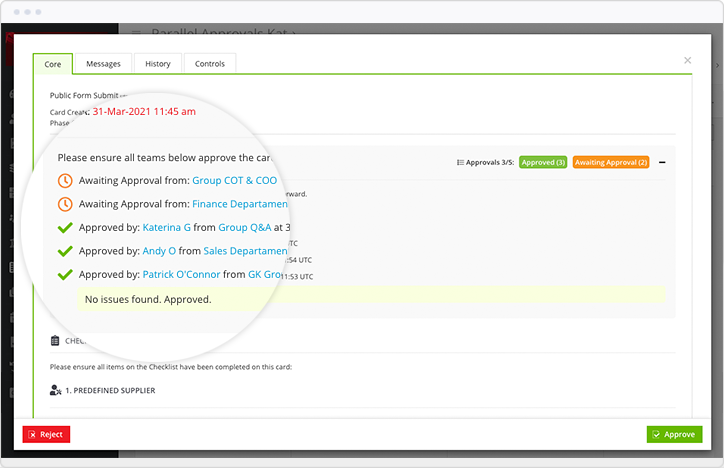 Parallel reviews and approvals within Gatekeeper
Parallel reviews and approvals within Gatekeeper
3. Assign contract ownership for effective collaboration and accountability
As the supplier contract moves through its lifecycle, there is no need for Procurement and Legal to share uncertainty over who should own which phase. With contract management software, ownership can be assigned - keeping both teams accountable for required actions and enabling cross-team collaboration as necessary.
Without structured processes, coordinating the actions of different teams can become onerous. This can quickly cause gaps, delay certain processes and drop significant volumes of work on these teams at short notice."
Gatekeeper resolves this issue with Dynamic Ownership. Based on a set of dynamic rules, actions will be automatically assigned to the relevant stakeholder - with notifications sent to get their attention.
As we’ve written about before, ownership drives accountability. Neither Procurement nor Legal want to be seen as the bottleneck so by coordinating ownership, they can work together to keep moving forward.
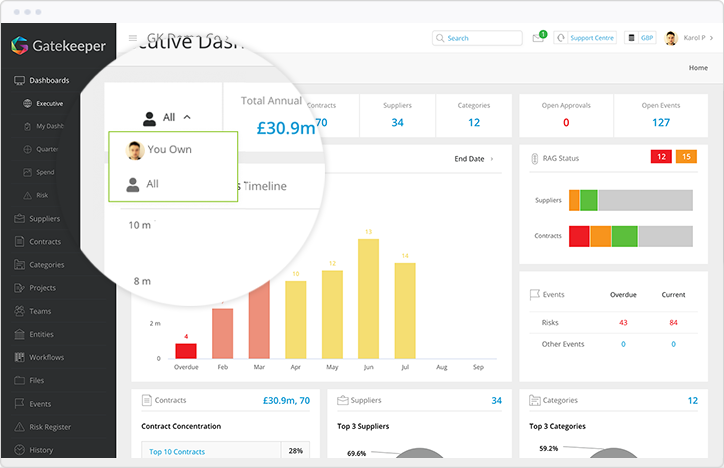 View the contracts you own within Gatekeeper
View the contracts you own within Gatekeeper
4. Procurement can negotiate for savings without leaving out Legal
Negotiating is often the most time-consuming phase of contract creation. Lengthy negotiations slow down time-to-signature, extend the procurement process and can be frustrating for both parties.
Negotiations have different inputs and expected outputs from Legal and Procurement - with risk and cost needing to be finely balanced for the contract to be compliant and profitable."
Rather than competing over who owns the negotiation process, which can result in silos, misunderstandings and a lack of clarity around obligations and outcomes, Gatekeeper lets teams work together.
Procurement and Legal can redline supplier contracts in MS Word® for ease of use, while those with Office365 licences can edit in Microsoft and save the new versions back into Gatekeeper.
This removes the need to download and re-upload documents. Instead, Legal and Procurement will make edits in a centralised platform. It saves time and also prevents document duplication - so both teams have visibility over accurate, up-to-date terms and agreements.
This feature speeds up the overall negotiation process and gives both teams the opportunity to focus on the aspects that will help them to drive better outcomes from suppliers.
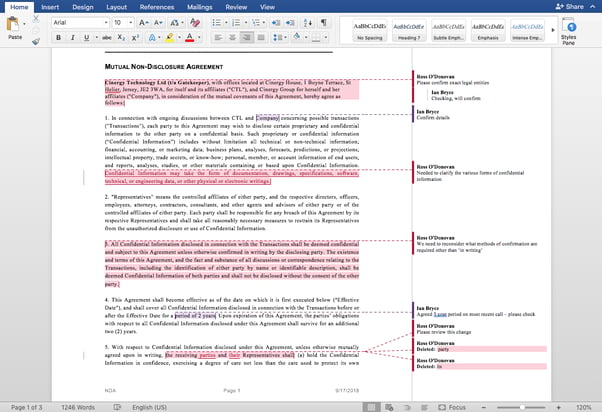 eNegotiate from Gatekeeper
eNegotiate from Gatekeeper
5. Delegate supplier data entry to eliminate manual chasing
Procurement and Legal teams both rely on complete and accurate records to support their goals of minimising regulatory and supplier risk. Gatekeeper supports this shared endeavour by giving teams the ability to delegate data entry securely to the prospective suppliers.
Procurement can make specific requirements mandatory for suppliers, while Legal can let Procurement know exactly what is needed for their requests to be processed as smoothly as possible.
When both teams work from the same information, contract and supplier risk management is simplified - putting your business in the best position to protect itself."
Using Public Forms and allowing for document upload mean teams only deal with compliant data. It makes the procurement process faster while minimising the contract administration that is often left on the shoulders of Legal.
By mandating what data should be uploaded, all relevant information is captured for effective procurement and Legal can have confidence that they are working with accurate and compliant data."
What’s more, this automation isn’t just confined to the initial engagement with suppliers. It can be replicated on an annual or other periodic basis as required to maintain document integrity. So, for example, the annual renewal of insurance certificates can be fully automated.
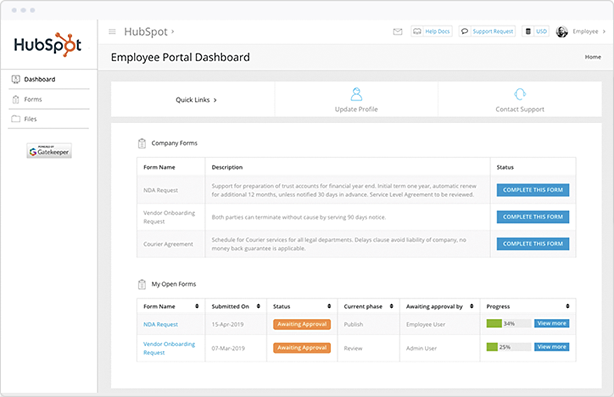 Delegate Data Entry via Public Forms
Delegate Data Entry via Public Forms
6. Engage with viable suppliers from the outset
Procurement and Legal teams don't have time to waste. That means protecting them from working with suppliers that are non-viable. By onboarding the wrong type of supplier or a third-party that increases risk to the point it's no longer manageable, both teams will have their work cut out for them.
When teams have to react to underperforming, non-compliant suppliers it means they're being distracted from strategic work to fight fires. Combined with a lack of ownership, inaction may occur as each department looks to the other for a resolution."
Contract management software can eliminate this reactivity early on. Using a solution that offers integrated risk intelligence feeds is perfect for both teams. Relevant stakeholders can easily view a potential supplier's background - including any changes to credit risk, scores and limits.
With a deeper understanding of third-parties, Legal and Procurement can have informed discussions about their suitability. It also helps to minimise risk and non-compliance further down the line.
Compliance becomes automated as notifications are sent in real-time to stakeholders. Information can be stored directly against the supplier record within the repository, so access and visibility are never an issue.
This is beneficial for existing third-party relationships that can also be assessed. By using Gatekeeper’s Kanban Workflow Engine, risk mitigation procedures can be triggered automatically - and assigned to a specific owner.
See supplier viability with MarketIQ
Wrap Up
Procurement and Legal teams work most successfully together when there is a shared vision, agreed priorities and a willingness to collaborate rather than compete.
Alignment of both processes and people is needed, but contract management software is the enabler that helps both teams to meet their goals.
To find out how Gatekeeper can bring your procurement and legal teams together, book a demo today.

.png)
.png)
.png)
-4.png)